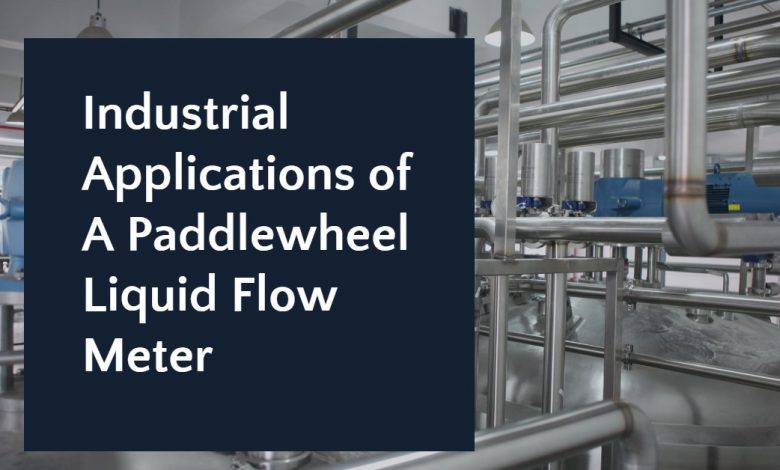Industrial Applications of a Paddlewheel Liquid Flow Meter

Various industrial processes are made effective by numerous devices and instruments used. When it comes to flow rate monitoring, sensing, and measurement, flow meters make ideal devices. Since many substances in industrial processes require measurement, the user needs to be acquainted with various liquid flow meter types and how they work.
Today, we focus on paddlewheel flow meters, providing you with details of their working principle in flow regulation and measurement. We will also explore the different types of paddlewheel flow meters and applications meant for each type of paddlewheel liquid flow meter.
What is a Paddlewheel Flow Meter?
Flow meters are categorized into five main entities: velocity flowmeters, differential pressure flow meters, positive displacement flow meters, mass flowmeters, and open channel flow meters; the paddlewheel flow meter belongs to the category’s velocity flow meters category. When measuring flow rate, velocity flow meters provide readings in volumetric flow rate. The volume is directly proportional to the fluid’s velocity. When the Reynold number exceeds 10000, the sensitivity of the paddlewheel flowmeter drops. Various types of velocity flow meters include vortex shedding, turbine, electromagnetic, ultrasonic, and paddlewheel flow meters.
Understanding different flow meters is essential if you want to buy the right liquid flowmeter for the right application. It will also help you know they are supposed to be installed and which media they are supposed to regulate or monitor. What differentiates the various types of paddlewheel flow meters include the type of material used to make it – plastic or stainless steel, how they evaluate or detect signals, which can either be through the optical sensor, hall sensor, coil sensor, or HT coil sensor. Below are different types of paddlewheel flow meters and how they work when measuring flow rate.
Different Paddlewheel Flow Meter Types
Plastic Inductive Detection and Pulse Output Paddlewheel Flow Meter
Also known as a PP or a PVDF paddlewheel, this flow meter has four molded permanent magnets located in the arms. These magnates rotate on two ceramic bearings and a resistant ceramic spindle with precision. Outside the fluid flow area, there is a hall sensor for detecting the magnetic field of the rotating paddle wheel. Each revolution generates two output signals. First, the rotational speed will determine frequency changes proportionally. An integrated electronics board then converts the signal into a square-wave frequency signal.
An example of these types of flow meters is the 8011 Paddlewheel flow meter. This paddlewheel flow meter measures flow continuously and measure solid-free liquids that are neutral and slightly aggressive.
Plastic Inductive Detection and Sinusoidal Output Paddlewheel Flow Meter
This is a PVDF or PP paddlewheel flow meter with four rotating molded permanent magnets in the arms. It also has two ceramic bearings that can resist wear and tear and a ceramic spindle. This helps it to rotate with precision. Placed outside the fluid’s flow area is a coil with a ferrite core. This coil is used to detect the magnetic field of the rotating paddle wheel. Proportionality the rotational speed of the paddlewheel; the frequency will change as generated by the revolution. The rotation of the paddlewheel generates a sinusoidal voltage signal. The flow rate is directly proportional to the voltage signal in the coil. No extra auxiliary power supply is required in this type of paddlewheel sensor since it is two wired. A display unit that operates using a battery is connected to allow voltage dependency.
An example of the sinusoidal output paddlewheel flowmeter is the 8012 Paddlewheel flow meter. It measures continuous flow and is designed with media that is free from solids, neutral, and slightly aggressive.
This type of flow meter can use either an optic measuring principle or a magnetic measuring principle. In the optic measuring version, infrared is used for liquid flow rate measurement.
Plastic Optical Detection and Pulse Output Paddlewheel Flow Meter
This paddlewheel flow meter is made from PVDF material and has two bearings and a spindle made from a ceramic material that doesn’t wear or tear. Placed outside the medium area in an electronic housing are two infrared transmitters and receivers. They are separated by plastic that allows through the passing of infrared radiation. These IR diodes are used to detect the paddlewheel rotation. Reflected I-Signal is converted to a square wave frequency signal by the integrated electronics. The square wave frequency signal is directly proportional to the flow rate. With this optical method, the flow rate is detected by ferromagnetic particles in the media. The particles are also used to detect the direction of the flow. An example of this type of paddlewheel flow meter is the 8039 Paddlewheel flow meter.
Type 8039 paddle flow meter comes with an extra-large display. It also has a special design that makes it easier to switch a valve for an On/Off control loop or the monitoring system. It is an all-in-one device that allows you to indicate, monitor, transmit, and On/Off control.
Stainless Steel Inductive Detection and Pulse Output Paddlewheel Flow Meter
This type of paddle flowmeter has very low characteristics of ferromagnetic and is made of stainless steel. Stainless steel or high-tech ceramic is used to make the spindle, while ceramic or PEEK is used to make the bearing. An HT coil with permanent magnets is found inside the top-mounted electronics. The HT coil also has electronics where a square wave frequency signal is provided from a coil signal. The flow rate is proportional to the converted square wave frequency signal. The paddle wheel rotational speed is proportional to the frequency changes. Therefore, every complete revolution generates two positive output signals. Fluids of temperatures up to 160°C (320°F) are often used with this type of paddlewheel flowmeter. Contaminants and ferromagnetic particles do not restrict the range of application.
An example of these types of flowmeter is the 8030 HT Paddlewheel flowmeter. This paddlewheel flow meter is commonly used in high-temperature applications, and it is an inline flow meter. It can regulate fluids with temperatures of up to 160°C. The flow meter is meant to measure slightly aggressive, neutral, and solid-free media.
Conclusion
To accurately measure and regulate clean liquids, paddlewheel flow meters are necessary. Using these types of flow meters with other fluids besides water may cause inaccuracies. The reason being that paddlewheel flow meters have moving parts inside that may get damaged by debris or dirt, forcing them to give wrong readings. Since they are very sensitive, the measured fluid should not be corrosive as it will also damage the moving parts.
Most paddlewheel flow meters are cost-effective because they are easy to install, use, and maintain. However, each type of paddlewheel flow meter will only work when paired with the right application. Therefore, ensure that you consider this critical factor before purchasing and installing a paddlewheel flow meter for your system. You can ask paddlewheel manufacturers to guide you when purchasing such a flow meter if you are unsure of the application requirements.





